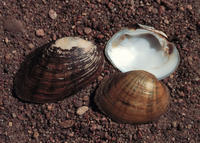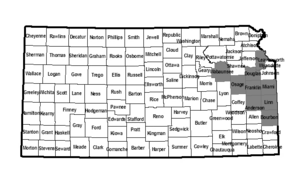MUCKET MUSSEL

The shell of the mucket (mussel) is oblong and generally compressed or moderately inflated. The anterior end is rounded, while the posterior end is bluntly pointed. Shell thickness ranges from moderate in young to very thick in older specimens. The coloration is yellowish-brown with green rays. Maximum length is about eight inches. Historically, the mucket was never widespread in Kansas, occurring along the Marais des Cygnes River from Osage County to the Missouri State line. The species is currently known from only two locales along the Marais des Cygnes River in Franklin and Miami counties. The species is generally found in large creeks and small to medium rivers with gravel, gravel-sand and gravel-silt substrates with moderate to swift currents. Adults will feed by filtering detritus and plankton from the water.

Mucket mussels are protected by the Kansas Nongame and Endangered Species Conservation Act and administrative regulations applicable thereto. Any time an eligible project is proposed that will impact the species' preferred habitats within its probable range, the project sponsor must contact the Ecological Services Section, Kansas Department of Wildlife, Parks and Tourism, 512 SE 25th Ave., Pratt, Kansas 67124-8174. Department personnel can then advise the project sponsor on permit requirements.
DESIGNATED CRITICAL HABITATSAs defined by Kansas Administrative Regulations, critical habitats include those areas documented as currently supporting self-sustaining population(s) of any threatened or endangered species of wildlife as well as those areas determined by the Kansas Department of Wildlife, Parks and Tourism to be essential for the conservation of any threatened or endangered species of wildlife.
Currently, the following areas are designated critical for Mucket Mussels:
(1) Marais des Cygnes River: from Melvern Reservoir (Osage County) to the Kansas-Missouri border (Linn County)
(2) Pottawatomie Creek: from the confluence of the South Fork of Pottawatomie Creek (Anderson County) to the confluence of the Marais des Cygnes River (Miami County.
(3) Marmaton River: from the confluence of Paint Creek (Bourbon County) to the Kansas-Missouri border
(4) Outside of the Osage system: Mill Creek (Waubansee County); Wakarusa River (Douglas County)







